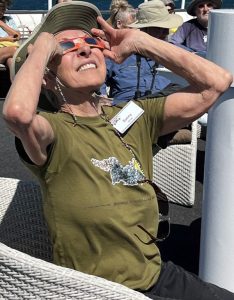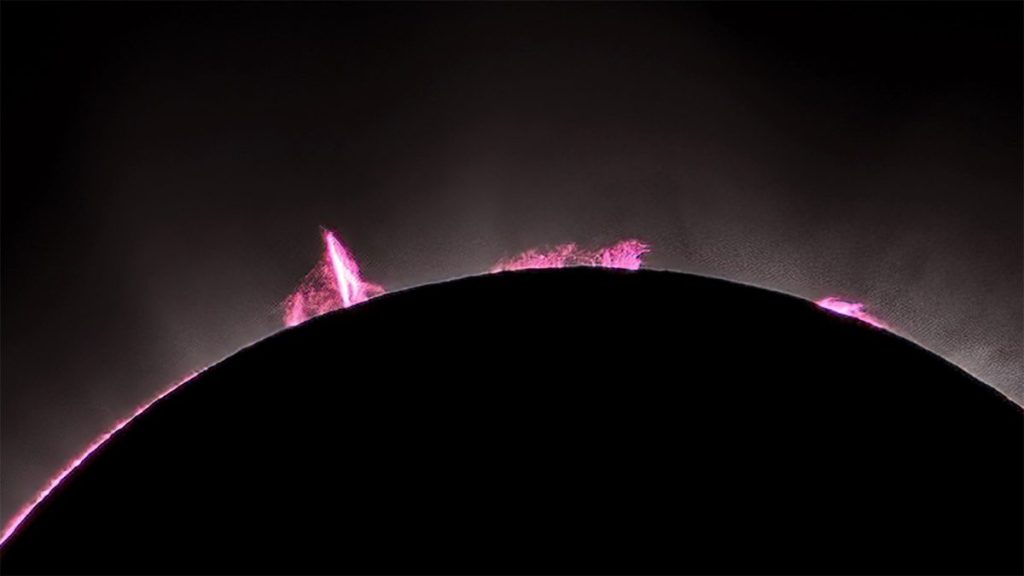
Our 2023 total solar eclipse cruise was perhaps the most lucky trip that we have ever taken. Almost everyone traveling to this hybrid eclipse was headed to Exmouth, Australia. We on the other hand chartered a ship in order to increase our flexibility in obtaining clear sky and targeted a different city north of Exmouth. However, a rare tropical cyclone formed several days prior to our departure and headed straight for our jumping-off point of Broome, Western Australia. It looked initially as if the cruise might be canceled or delayed and that Broome potentially might even be hit extremely hard by this hurricane equivalent.

A fantastic image recorded by Eliot Herman showing incredibly fine detail in prominences seen during totality. Nikon Z7II, 400 mm lens, 1.4 x teleconverter, f7.1, exposures vary the best flare picture is 27 images stacked that have varying +/- 1 stop. The top image is before Eliot worked for 2 weeks to process it to obtain the best resolution which is shown in the lower image. Note that the vertical structure in the 11 o’clock position is not a prominence but actually a solar tornado that was spinning before later moving up into the Sun’s atmosphere and disappearing. The tornado was captured by Miguel Claro in Portugal, far away from the eclipse path, but I recommend you take a look.
ECLIPSE LOCATIONS
Our ship, Coral Expeditions Coral Discoverer was to maneuver into the path of totality for our observation. However, given that a moving ship is not the best setup to take photos I searched a land location that could be a more stable spot for the more serious photographers. That turned out to be Ah Chong Island. The primary concern was the overall weather and any effects Cyclone Ilsa might have had on the area where we were scheduled to sail. As it was we had to bypass one area because of damage inflicted by its passage but the eclipse observation spots were not impacted. These were located in the Montebello Island area. Due to the overall short duration of totality at the center (65 seconds) we had to plan this quite carefully.
Site surveying from afar can be tricky business. As an example, prior to the July 22, 2009, total eclipse, I was able to get access to the WWII island of Iwo Jima where I had hoped we could land a group. Unfortunately, 4 months before the eclipse the Japanese government disapproved our chartered flight from landing for the eclipse but yet I was able to get on the island, walk the beach and choose some good sites. The photo below shows the location of Iwo Jima between the center and south limits of that eclipse 14 years ago. In the end, I had to move our second observation site to the island of Butaritari in Kiribati while our primary group observed from China.
Although planning for this eclipse was not as challenging as that of the 2009 TSE it was not easily accomplished by just using online imagery. It did require a real survey. Ah Chong has 4 beaches but on eclipse day up to 45-knot winds were blowing from the east toward the ship; not as high on the island sites but still blowing. This was not an ideal situation for disembarking the team. Prior to traveling to Australia, I decided to choose the northern beach because the beach had some minor protection from a berm and it was accessible using the ship’s landing craft; the west beach appeared too small and perhaps too shallow for landing. The day before the eclipse Byron and I traveled in a Zodiac with 2 crew members to scout. It was a truly miserable experience because of the awful seas and difficulty maneuvering the Zodiac between islands. It took hours just to finish scouting and be retrieved by the ship. But on eclipse day the team was able to travel in the larger Xplorer craft which was better able to maneuver and more comfortable; after scouting they chose the western beach which opposed the wind direction and had the best protection. Fifteen members of our team elected to land on Ah Chong while the remaining 51 elected to observe from the ship positioned in the sea but with additional challenges. In the image below the range they set up was between the yellow and blue arrows.
I intended to place the ship on the centerline but this proved impossible due to the combination of choppy seas and high winds. In addition, there were a number of oil rigs in the area and 3-mile exclusion zones complicated the positioning. During the hours preceding the eclipse start the ship was buffeted and it was noticed that when the ship was moving in a preferential direction the effects were less than if heading into the wind or if anchored. I decided to set up the ship to move in a zig-zag pattern timed to change between the start and end of totality.
ECLIPSE SITE LOCATIONS